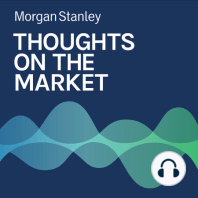3 min listen

Andrew Sheets: Is 60:40 Diversification Broken?
Andrew Sheets: Is 60:40 Diversification Broken?
ratings:
Length:
4 minutes
Released:
Jul 29, 2022
Format:
Podcast episode
Description
One of the most common standards for investment diversification, the 60:40 portfolio, has faced challenges this year with significant losses and shifting correlations between stocks and bonds. Is this the end of 60:40 allocation?---- Transcript -----Welcome to Thoughts on the Market. I'm Andrew Sheets, Chief Cross Asset Strategist for Morgan Stanley. Along with my colleagues, bringing you a variety of perspectives, I'll be talking about trends across the global investment landscape and how we put those ideas together. It's Friday, July 29th, at 2 p.m. in London.The so-called 60:40 portfolio is one of the most common forms of diversified investing, based on the idea of holding a portfolio of 60% equities and 40% high-quality bonds. In theory, the equities provide higher returns over time, while the high-quality bonds provide ballast and diversification, delivering a balanced overall portfolio. But recently, we and many others have been talking about how our estimates suggested historically low returns for this 60:40 type of approach. And frequently these estimates just didn't seem to matter. Global stocks and bonds continued to hum away nicely, delivering unusually strong returns and diversification.And then, all at once, those dour, long term return estimates appeared to come true. From January 1st through June 30th of this year, a 60:40 portfolio of U.S. equities and the aggregate bond index lost about 16% of its value, wiping out all of the portfolio's gains since September of 2020. Portfolios in Europe were a similar story. These moves raise a question: do these large losses, and the fact that they involved stock and bond prices moving in the same direction, mean that diversified portfolios of stocks and bonds are fundamentally broken in an era of tighter policy?Now, one way that 60:40 portfolios could be broken, so to speak, is that they simply can't generate reasonable returns going forward. But on our estimates, this isn't the case. Lower prices for stocks and higher yields on bonds have raised our estimate for what this type of diversified portfolio can return. Leaving those estimates now near the 20-year average.A bigger concern for investors, however, is diversification. The drawdown of 60:40 portfolios this year wasn't necessarily extreme for its magnitude—2002 and 2008 saw larger losses—but rather its uniformity, as both stocks and bonds saw unusually large declines.These fears of less diversification have been given a face, the bond equity correlation. And the story investors are afraid of goes something like this. For most of the last 20 years, bond and equity returns were negatively correlated, moving in opposite directions and diversifying each other. But since 2020, the large interventions of monetary policy into the market have caused this correlation to be positive. Stock and bond prices are now moving in the same direction. The case for diversification is over.This is a tempting story, and it is true that large central bank actions since 2020 have caused stocks and bonds to move together more frequently. But I think there's also a risk of confusing direction and magnitude. Bonds can still be good portfolio diversifiers, even if they aren't quite as good as they've been before.Even if stocks and bonds are now positively correlated, that correlation is still well below 1 to 1. That means there are still plenty of days where they don't move together, and this can matter significantly for how a portfolio behaves, and how diversification is delivered, over time.Another important case for 60:40 style diversification is volatility. Even after one of the worst declines for bond prices in the last 40 years, the trailing one-year volatility of the US aggregate bond index is about 6%. That is one third the volatility of U.S. stocks over the same period. Having 40% of a portfolio in something with one third of the volatility should dampen overall fluctuations. For all these reasons, we think the case for a 60:40 style a
Released:
Jul 29, 2022
Format:
Podcast episode
Titles in the series (100)
Andrew Sheets: For Markets, Signs, Signs, Everywhere Signs by Thoughts on the Market